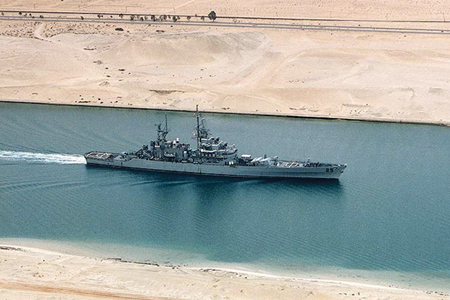
Looking Back - On the Canal: From Umar to Osama
Issue 96 September
Tam Hussein relates how the Suez Canal did more than just connect two seas; it created a path for the US to enter the Middle East.
When the governor of Egypt, ‘Amr b. al-As proposed to dig a canal that connected the Red Sea with the Mediterranean, Umar b. al-Khattab refused. The second caliph feared that it would leave the holy cities exposed to foreign invasion. That concern certainly had merit; in the 12th century Crusaders attempted a daring raid on Makkah and Madinah by carrying their ships across land to the Gulf of Aqaba on the Red Sea. Saladin’s navy averted the danger and the captives were executed or taken to Cairo. In some ways Umar b. al-Khattab’s prescience anticipated the geopolitical importance of the Suez.
But the idea of connecting the two seas was revived with Western ascendancy in 18th century. And in 1885 a joint Anglo-French venture realised that the project would shorten the lucrative route to British India by several months. At the dawn of the 20th century with the increasing reliance on oil, the geopolitical importance of the canal increased. But whilst the British and the French reaped the benefits from the canal, the Egyptians saw none. However, 1952 a military coup lead by General Neguib and masterminded by Colonel Gamal Abdel Nasser changed all of that. Colonel Nasser aimed to reinvigorate Egypt and kick out the British presence forever; for in spite of independence there were still 70, 000 British troops in the Suez area.
Nasser managed to persuade the British to withdraw from Egypt. However, with the Cold War in full swing, the USA looked to Egypt as an ally against Russia. The US made overtures towards Nasser to side against the Russians by offering generous bribes. Nasser accepted the bribes, but refused to follow a pro-American line. In his view, to consider the USSR as a greater threat than Britain, who occupied and controlled the Suez Canal, seemed absurd. His policy was clear; he wanted Britain out but also wanted to be safe from Israel, whose greatest supporter was the US.
However, the British attempt to isolate Egypt in the Middle East only drew Nasser closer to the Russians. In 1955, he shocked the West by purchasing Russian arms from Czechoslovakia. The US then made a fatal mistake: in the hope of influencing policy and removing Nasser, the US withheld crucial loans needed to build the Aswan Dam that would strengthen the Egyptian economy. With no money to finance the project Nasser nationalised the Suez Canal on 26th of July 1956.
Bookmark this |
|
Add to DIGG |
|
Add to del.icio.us |
|
Stumble this |
|
Share on Facebook |
|
Share this |
|
Send to a Friend |
|
Link to this |
|
Printer Friendly |
|
Print in plain text |
|


Comments
0 Comments